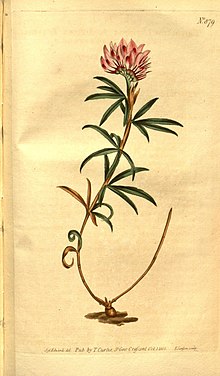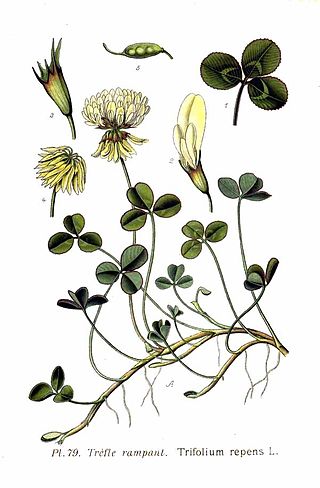
Clover, also called trefoil, are plants of the genus Trifolium, consisting of about 300 species of flowering plants in the legume family Fabaceae originating in Europe. The genus has a cosmopolitan distribution with highest diversity in the temperate Northern Hemisphere, but many species also occur in South America and Africa, including at high altitudes on mountains in the tropics. They are small annual, biennial, or short-lived perennial herbaceous plants, typically growing up to 30 centimetres (12 in) tall. The leaves are trifoliate, with stipules adnate to the leaf-stalk, and heads or dense spikes of small red, purple, white, or yellow flowers; the small, few-seeded pods are enclosed in the calyx. Other closely related genera often called clovers include Melilotus and Medicago.

Trifolium repens, the white clover, is a herbaceous perennial plant in the bean family Fabaceae. It is native to Europe, including the British Isles, and central Asia and is one of the most widely cultivated types of clover. It has been widely introduced worldwide as a forage crop, and is now also common in most grassy areas of North America, Australia and New Zealand. The species includes varieties often classed as small, intermediate and large, according to height, which reflects petiole length. The term 'white clover' is applied to the species in general, 'Dutch clover' is often applied to intermediate varieties, and 'ladino clover' is applied to large varieties.

Trifolium pratense, red clover, is a herbaceous species of flowering plant in the bean family Fabaceae, native to Europe, Western Asia, and northwest Africa, but planted and naturalized in many other regions.
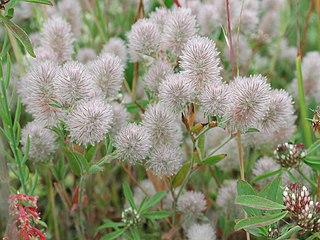
Trifolium arvense, commonly known as the hare's-foot clover, rabbitfoot clover, stone clover or oldfield clover, is a flowering plant in the bean family Fabaceae. This species of clover is native to most of Europe, excluding the Arctic zone, and western Asia, in plain or mid-mountain habitats up to 1,600 metres (5,200 ft) altitude. It grows in dry sandy soils, both acidic and alkaline, soil with dry-mesic conditions and is typically found at the edge of fields, in wastelands, at the side of roads, on sand dunes, and opportunistically in vineyards and orchards when they are not irrigated.
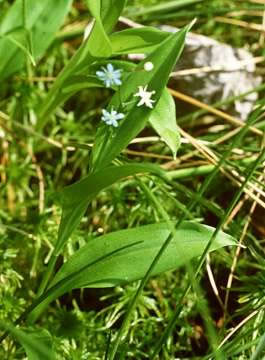
Maianthemum trifolium is a species of flowering plant that is associated with extremely wet environments and is native to Canada and the northeastern United States as well as St. Pierre and Miquelon and Asia (Siberia).

Medicago lupulina, commonly known as black medick, nonesuch, or hop clover, is a plant of dry grassland belonging to the legume or clover family. Plants of the genus Medicago, or bur clovers, are closely related to the true clovers (Trifolium) and sweet clover (Melilotus). Like the true clovers, black medick has three leaflets and a small, yellow flower closely resembling those of lesser trefoil. Black medick belongs to the same genus as alfalfa.
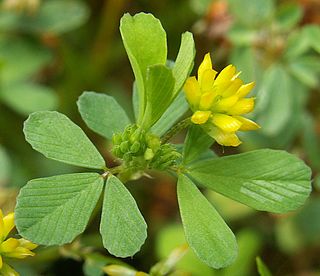
Trifolium dubium, the lesser trefoil, suckling clover, little hop clover or lesser hop trefoil, is a flowering plant in the pea and clover family Fabaceae. This species is generally accepted as the primary plant to represent the traditional Irish shamrock.

Trifolium hybridum, the alsike clover, is a species of flowering plant in the pea family Fabaceae. The stalked, pale pink or whitish flower head grows from the leaf axils, and the trifoliate leaves are unmarked. The plant is up to 40 centimetres (1.3 ft) tall, and is found in fields and on roadsides – it is also grown as fodder. It has been linked with toxicity in horses and has some agricultural uses. The plant blooms from spring to autumn. Originating in mainland Europe, it has become established as an introduced plant in the British Isles and throughout the temperate regions of the world.

Trifolium alexandrinum is an annual clover cultivated mostly in irrigated sub-tropical regions, and used as leguminous crop. It is an important winter crop in Egypt, where it may have been cultivated since ancient times, and was introduced into northern India in the early nineteenth century. It is also grown in the United States, Europe, China and Australia.
Trifolium bolanderi is a species of clover known by the common names Bolander's clover and parasol clover.

Trifolium rubens is a species of flowering plant belonging to the family Fabaceae.

Trifolium spadiceum is a species of flowering plant belonging to the family Fabaceae.

Trifolium virginicum, the Kate's Mountain clover, is a species of flowering plant in the family Fabaceae. It is native to West Virginia and Virginia in the United States, growing mainly on the Piedmont mafic barren, with Kate's Mountain as the type locality. Trifolium virginicum is a symbol of the West Virginia Native Plant Society. T. virginicum can also be found in Maryland and Pennsylvania, where it is considered imperiled or critically imperiled, respectively, by NatureServe.

Trifolium alpestre, the owl-head clover or purple-globe clover, is a species of flowering plant in the family Fabaceae, native to central, southern and Eastern Europe, the Caucasus, Turkey, and Iran. It reproduces both clonally and by seed.

Trifolium ambiguum, the kura clover or Caucasian clover, is a species of flowering plant in the family Fabaceae. It is native to Ukraine, Crimea, south European Russia, the northern Caucasus, eastern Turkey, Iraq, and Iran, and has been introduced to New South Wales. Planted for forage, once established it is tolerant of close grazing, and is also useful for honey production.
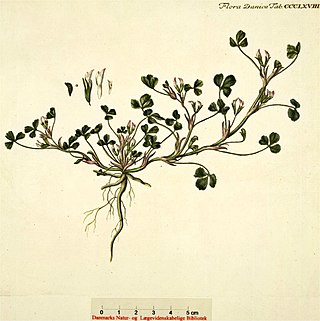
Trifolium ornithopodioides, the bird's foot clover, is a species of flowering plant in the family Fabaceae. It is native to Europe, Madeira, and northwestern Africa, and has been introduced to Australia and New Zealand. It is a halophyte.

Trifolium semipilosum, the Kenya clover or Kenya white clover, is a species of flowering plant in the family Fabaceae. It is native to Yemen, Eritrea, Ethiopia, Kenya, Uganda, Tanzania, Malawi and Zimbabwe, and has been introduced to Saint Helena. It is a close wild relative of the important forage crop Trifolium repens.
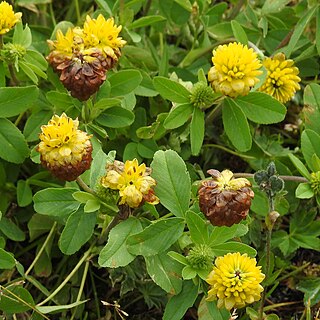
Trifolium badium, the brown clover or brown trefoil, is a species of flowering plant in the family Fabaceae, native to most of mainland Europe, the Caucasus, Turkey, Iraq, and Iran. It is a locally important forage in sub-alpine pastures.
Trifolium tembense, the Tembien clover or African clover, is a species of flowering plant in the family Fabaceae, found in Eritrea, Ethiopia, Democratic Republic of the Congo, Rwanda, Uganda, Kenya, and Tanzania. A locally important forage species, it thrives in wet areas, often growing in shallow water.
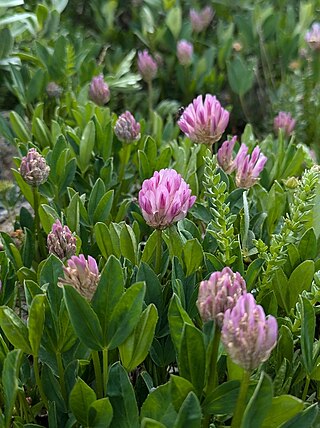
Trifolium parryi, commonly known as Parry's clover or Parry clover, is a high altitude species of plant from the western United States. It grows in the Rocky Mountains from southern Montana to northern New Mexico. It is a short plant that is adapted to the harsh conditions and short growing season near and above timberline.
